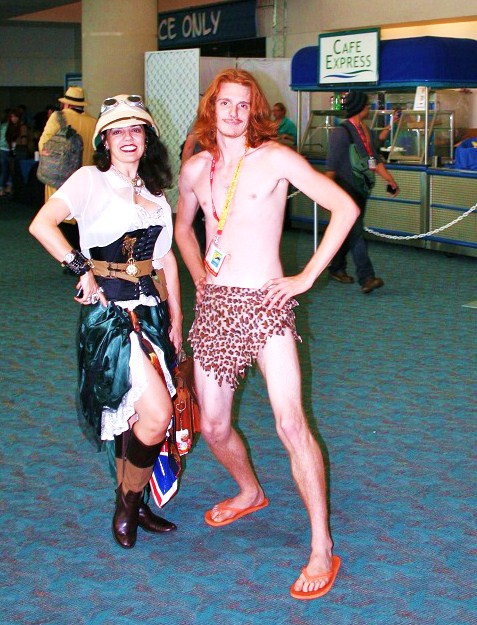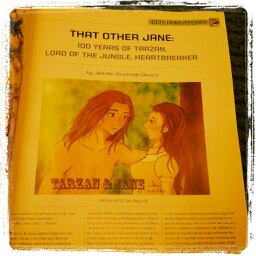
That Other Jane: 100 Years of Tarzan, Lord of the Jungle, Heartbreaker
by Jennifer Susannah Devore
"I was so jealous. I thought she was a wimp. I was sure I’d have been a better mate. " -that other Jane … Goodall

Herein lies the innate appeal of Edgar Rice Burroughs’ Tarzan, Lord of the Apes. Be he an object of affection, admiration or competition, Tarzan falls neatly into the untidy world of animal instinct, feral existentialism and personal authority: a Lord Greystoke of the Flies, if you will.
Burroughs composed an enduring theme and a permanence of characters spawning not only a succession of film and television iterations, but also serial books and eventually comics, penned not by Burroughs himself, but a veritable jungle encampment of devotees. From Dell Comics' cheerful adventure yarns of the 1940s, which featured a ripped, yet stick-thin version of Tarzan, to Psychology Press' Ways of Being Male: representing Masculinities in Children's Literature and Film by John Stephens to George of the Jungle, Tarzan has been a centenary of topic. Scholars may argue a garden of reasons why the jungle Brit in the loincloth has remained ever so popular; but the reader's heartbeat will tell you unequivocally there exists solely one answer. Stimulation.
Certainly, the sight of a well-sculpted, 1930s Johnny Weissmuller slicing into a sheath of river or even the hot, animated Disney Tarzan of 1999 swinging on a vine (Watch out for that treeeeee!), brings a swoon to many a fan, just as Captain Jack Sparrow, Indiana Jones or Han Solo does. Be not fooled, it is not simply the silky hair flop, the cheekbones and the swagger (uh – well, it kind of is). It is primarily what brings about said-swagger and the flip of that flop which oft has a nuclear power to melt its unsuspecting, doe-eyed victims like wax. It is the hero’s confidence, fearlessness and willingness to machete his way through the jungles and bridge the rivers, only to pop back to the surface victorious and, even if a bit broken, durable enough to shake off the snakes, the leeches and the authorities to forge ahead.
Edgar Rice Burroughs, born of Mid-western stubbornness and raised on Western ruggedness weathered the literal, as well as figurative, frontier realities of a changing America at the turn of the 20th Century. The son of a Civil War veteran and a protective yet yielding mother of six boys, two having died as infants, Edgar was the youngest of a large and prosperous family prone to enterprise, exploits and chance. From Chicago business ventures to Idaho gold dredging and cattle ranching, a young Edgar saw a world of possibilities; he certainly recognized his growing America was whatever a man wanted it to be. After a smattering and sampling of job-jobs like railway security, clerical manager, door-to-door salesman, pencil sharpener wholesaler, ditch digger and accountant, amongst others, Edgar found his future in the fertile pages of pulp fiction.
Burroughs would state later that if people were paid for writing rot such as I read in some of those magazines that I could write stories just as rotten. This was in the same spirit as, Mark Twain, claiming some thirty years previous and Hunter S. Thompson claiming some eighty years after Twain, that a lot of folks make an awful lot of money writing some really awful schlock. It appears the unifying theme was, hopefully, they might be equally as fortunate. Mark Twain summed it up best when

he prognosticated about Huckleberry Finn, They have expelled this from their library as, quote, trash and suitable only for the slums! That will sell 25,000 copies for us, sure.
Screaming through his tales, like Carol Burnett’s clear-as-a-bell Tarzan yell, Burroughs’ Wanderlust and spirit for adrenaline ripped through his tales of pirates, jungles, space, cavemen, dinosaurs and, lest we forget, The Land that Time Forgot. Over the decades of his long and successful life, Tarzan would be his Goose That Laid the Golden Egg. If Tarzan book money was good, Tarzan film money was out of this world.
The first celluloid representation was Tarzan of the Apes (1918) starring Elmo Lincoln as the silent hero. Whilst this iteration would follow most closely the events of the original novel, it was Tarzan the Ape Man (1932) that would explode out of the water like a surfacing submarine to penetrate pop culture. It would give us not only a taut and toned Olympic gold medallist swimmer named Johnny Weissmuller but also, as the first Tarzan film with sound, that iconic Tarzan yell which many will cringingly attempt. Raise your hand if you never tried it while swinging from the monkey bars on the playground.
As they often do, successful writer/film types take those sawbucks and buy Hollywood ranches, Palm Desert compounds, Caribbean islands or spooky manses in the Maine woods. Burroughs bought a sprawling one of the former just north of H-town. As a testament to the zeitgeist in 1923, the residents and citizens of the L.A. suburb burgeoning around his ranch, voted to incorporate as the town of Tarzana. Just five years previous, he had already incorporated himself: a savvy and uncommon move for a writer of this era.
Adventurous in word as well as deed to the end, Burroughs served as a WWII correspondent in Hawaii, embedded with U.S. Air Force bombers and even crossing paths with his equally unflappable son, Hulbert, a war photographer. After the war, he returned to the sunny jungle of Tinsel Town. Passing away in 1950, he would miss the continuing success of Tarzan throughout the Fifties via comic books and reprints of his novels and serials. He would also miss out on the explosive rebirth of his chef d’oeuvres as the Sixties would bring Tarzan the television series and a paperback book smash that introduced “Me Tarzan, you Jane”, their son, Boy, and a charming chimp named Cheeta to a whole new generation of restless rowdies ready for anything that wasn’t suburbia.
“It was somewhere between ten and eleven that I read Tarzan and decided I would go to Africa, live with animals and write books about them,” Dr. Jane Goodall, founder and mentor of the Jane Goodall Institute, recounts in a 60 Minutes interview. One-hundred years after the initial October 1912 publication of Tarzan of the Apes in All-Story magazine, Edgar Rice Burroughs’ creations match, if not absolutely mirror, mankind’s quest for self, sufficiency, survival and stimulation … well, and the cheekbones.
From creatures At The Earth’s Core, to a Martian Princess to the Lord of the Jungle, from The Cave Girl to The Girl From Hollywood to The Mucker and Pirates From Venus, Burroughs proffers vicarious pleasures and fantasy to the desk-bound, the cubicle-trapped and the homebodies of the planet. Simultaneously, he gives hope, inspiration and itineraries to the modern-day travelers and dreamers of the world.
Wanderlust is just ein deutsch Wort away from lust. Adventure-lit hits all the right buttons. Burroughs and Tarzan sliced their own paths, just like Captain Jack, Han Solo, Grizzly Adams and each real-life Indiana Jones throughout modern history, including the likes of Margaret Mead, Diane Fossey, Alan Shepard, Buzz Aldrin, Jacques Cousteau, John Glenn, Charles Lindbergh, Sally Ride, Teddy Roosevelt, Neil Armstrong, Gus Grissom, Valentina Tereshkova, Admiral Richard Byrd, Sir Richard Branson, Sir Edmund Hillary, Amelia Earhart, all the Monkeynauts and, finally … that other Jane.
In an October 2010 CBS 60 Minutes interview, reporter Lara Logan asked Dr. Jane Goodall: Why Africa? Dr. Jane replied: Because of reading Doctor Dolittle and Tarzan. Doctor Dolittle rescues animals from the circus and takes them back to Africa. And then, Tarzan, of course. The Lord of the Jungle.
Then the subject of Jane Porter, Tarzan’s girl, arose. In a statement soaked with decades of irritation and disgust, Dr. Jane exclaimed: I was passionately in love. He marries that other, stupid Jane. I think I’d have been the perfect mate for Tarzan, don’t you?
While today we’re bombarded with everyone else’s imagination, it’s satisfying to recall an era when we worked our own, fueled simply by Burroughs’ words … and, at least in Jane’s case, the loincloth. Now that’s what I call stimulation.
Author bio: Jenn ifer Susannah Devore authors the historical-fiction series Savannah of Williamsburg, as well as the contemporary The Darlings of Orange County. She is a regular contributor to GoodtobeaGeek.com under the pseudonym Hannah Hart, ghostdame of the Hotel del Coronado; her tribute to the 60th anniversary of Peanuts was published in the 2010 Comic-Con Souvenir Book She lives on a San Diego beach with her husband, a Pomeranian and an immortal cat she believes is Binx from Hocus Pocus.
ifer Susannah Devore authors the historical-fiction series Savannah of Williamsburg, as well as the contemporary The Darlings of Orange County. She is a regular contributor to GoodtobeaGeek.com under the pseudonym Hannah Hart, ghostdame of the Hotel del Coronado; her tribute to the 60th anniversary of Peanuts was published in the 2010 Comic-Con Souvenir Book She lives on a San Diego beach with her husband, a Pomeranian and an immortal cat she believes is Binx from Hocus Pocus.
Article reprinted by me, with my very own permission, from the 2012 Official Comic-Con Souvenir Book
Special thanks, again, to Gary Sassaman, Director of Print and Publications Comic-Con International: San Diego
Read all my SDCC Souvenir Book articles here!
Follow @JennyPopCom Twitter and Insta
JennyPop's Amazon Author Page, to boot!



